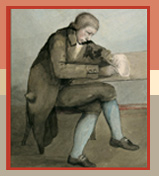
Iolo's Life
Autobiographical material (NLW 21387E)
The Agricultural Observer and Farmer
The Stonemason
Iolo has earned a name for himself as one of the architects of modern Welsh nationhood, but for most of his life he earned his bread and butter as a stonemason. Iolo and his brothers were raised to follow their father's trade, and they worked together regularly in Glamorgan and the surrounding area.
A possible example of the work of Edward Williams, senior, may be found in Gileston church. Iolo claimed to have learned to read by watching his father carve names on gravestones. Iolo may have devised this story in an attempt to mould his own public image. His status as a self-educated labouring-class poet (such as Anne Yearsley and Robert Burns) was central to the portrait of himself that he presented in Poems, Lyric and Pastoral (1794).
After his mother's death in 1770, Iolo spent a period working as a journeyman mason in south-west England, and lived in London, Bristol, Bath, Kent, Dorset, Devon and Somerset. From the mid-1770s onwards he established a business in Glamorgan, though he continued to run his brother Thomas's workshop in Wells for a short period in 1785.
According to his advertisements, Iolo was an accomplished stonemason. He could undertake a wide range of tasks in stone and marble: chimney pieces, memorials and gravestones. Examples of his craftsmanship still survive: a memorial for Anthony Jones, Llantwit Major; the tombstone of his father-in-law, Rees Robert(s), St Mary Church; and in Gileston cemetery.
Several of Iolo's architectural sketches have also survived, including a plan for the ideal cottage and a sketch of his home in Flemingston.
Taliesin Williams also learned the stonemason's craft from his father, and a handbill advertising their work from about 1805 survives (NLW 21418E, no. 13v). However, Taliesin did not follow his father's trade. In 1816 he established a 'Commercial School' in Merthyr Tydfil with the money he inherited from John, his father's brother, who had made his fortune after emigrating to Jamaica.
A sentimental portrait of the stonemason's life is depicted in one of Iolo's Welsh songs, 'Cân y Maensaer'; a more salacious view appears in his English 'Stonecutter's Song' (NLW 21392F, no. 73.) [Click here to listen to the (mp3) The song was recorded especially for the Iolo Morganwg Project by the folk group 'Simply English'. For more on the group go to http://andyrouse.com/se/ ].
Iolo's work as a stonemason and his antiquarian interests overlap. He devised a romantic story about the elegant porch of Beaupré Castle in order to enhance the esteem in which Glamorgan and its inhabitants were held. Around 1789 he discovered the Samson pillar-stone in the graveyard of St Illtud's church, Llantwit Major.



 'Stonecutter's Song' (copyright 'Simply English')
'Stonecutter's Song' (copyright 'Simply English')